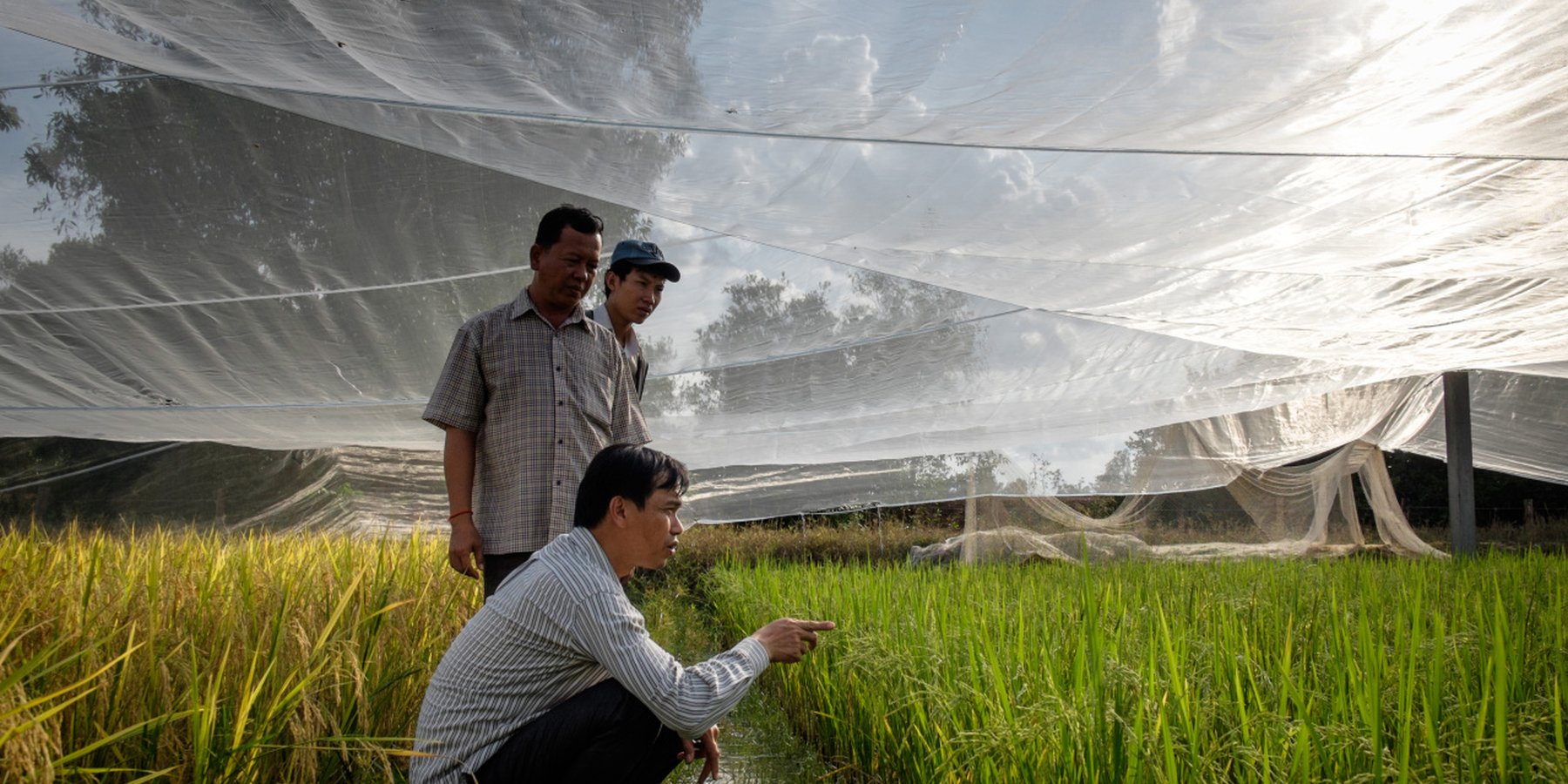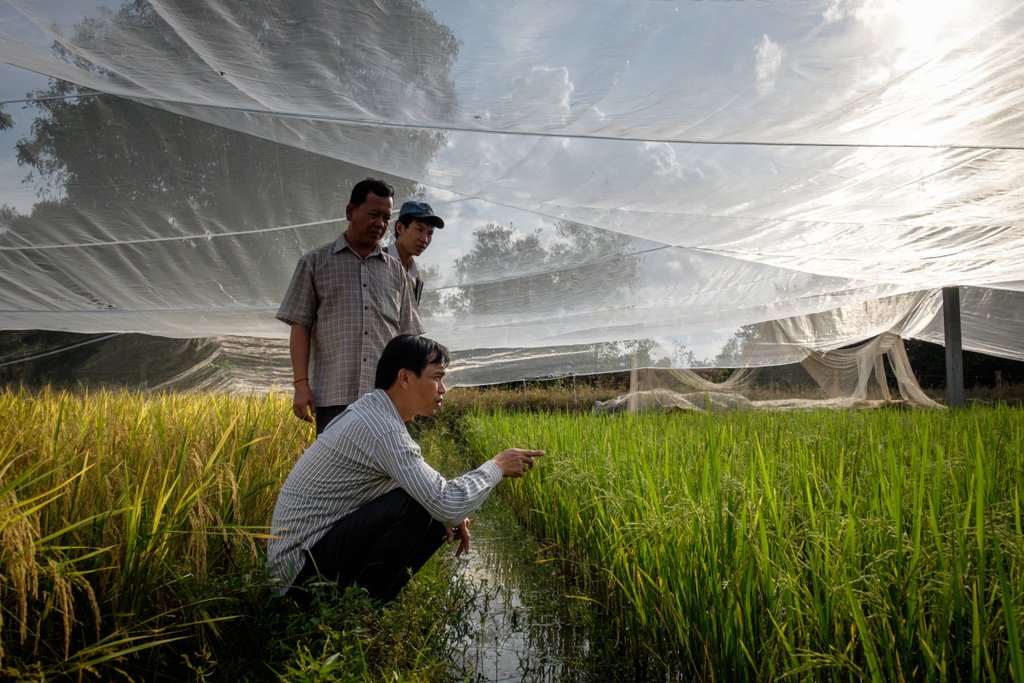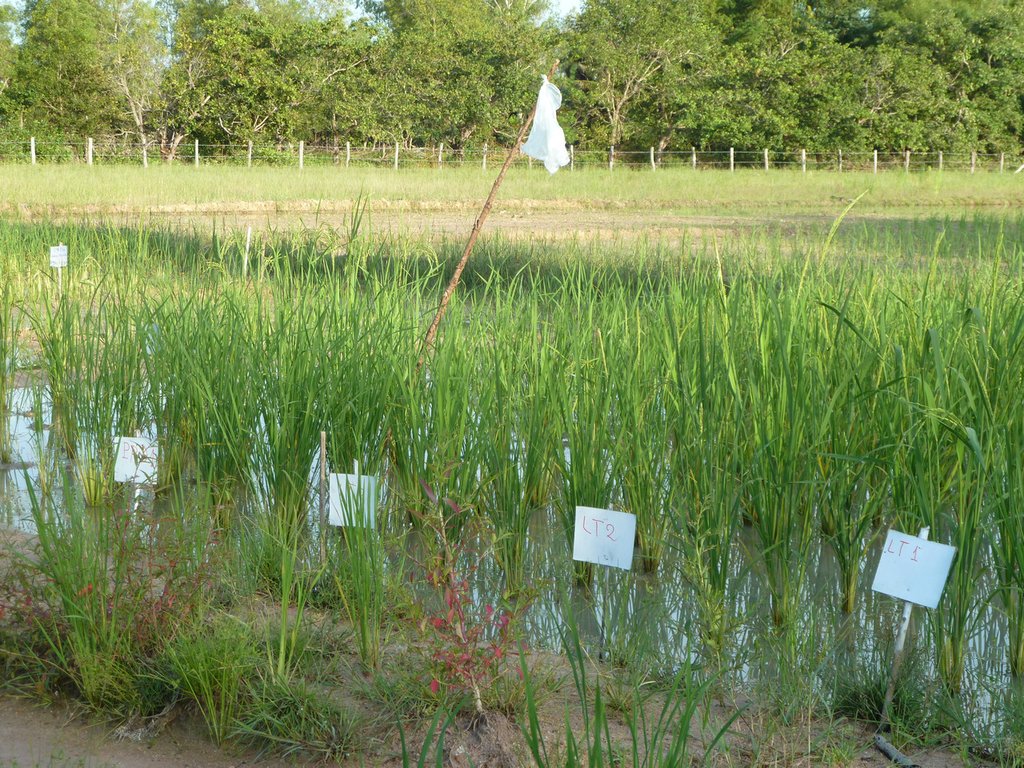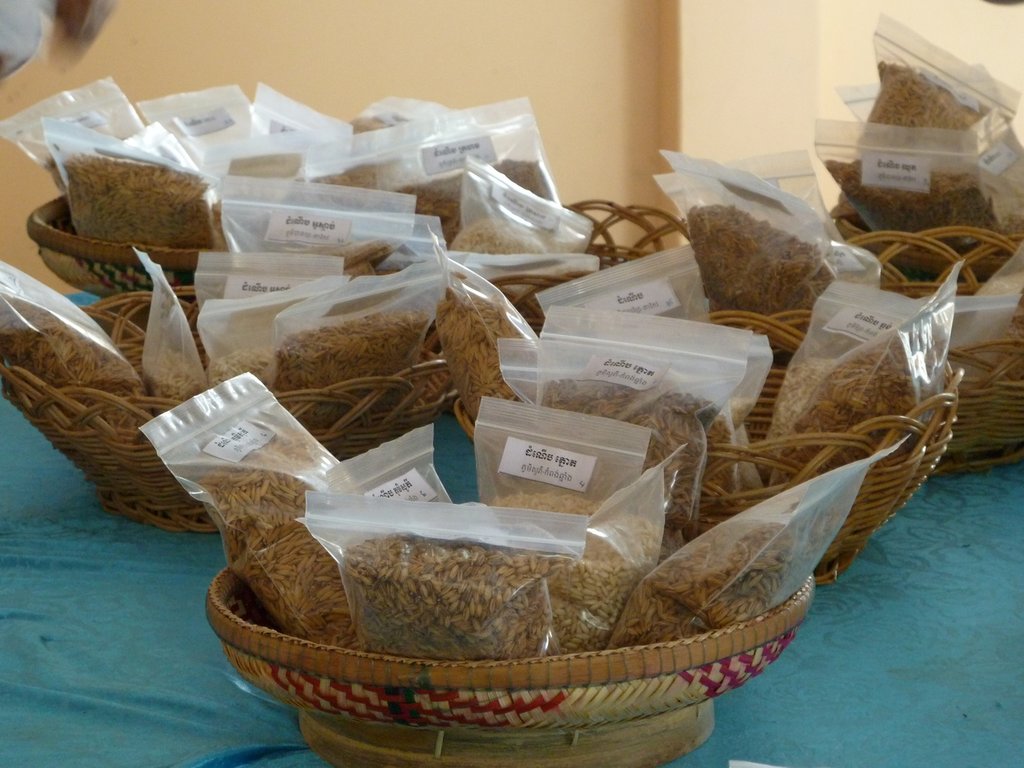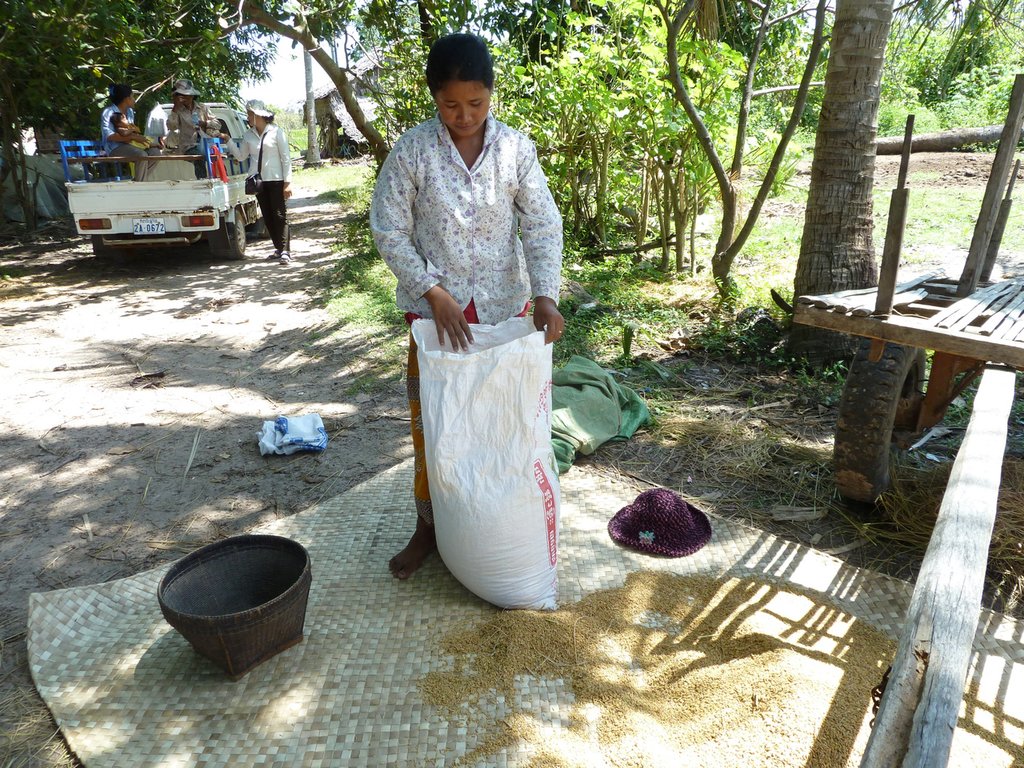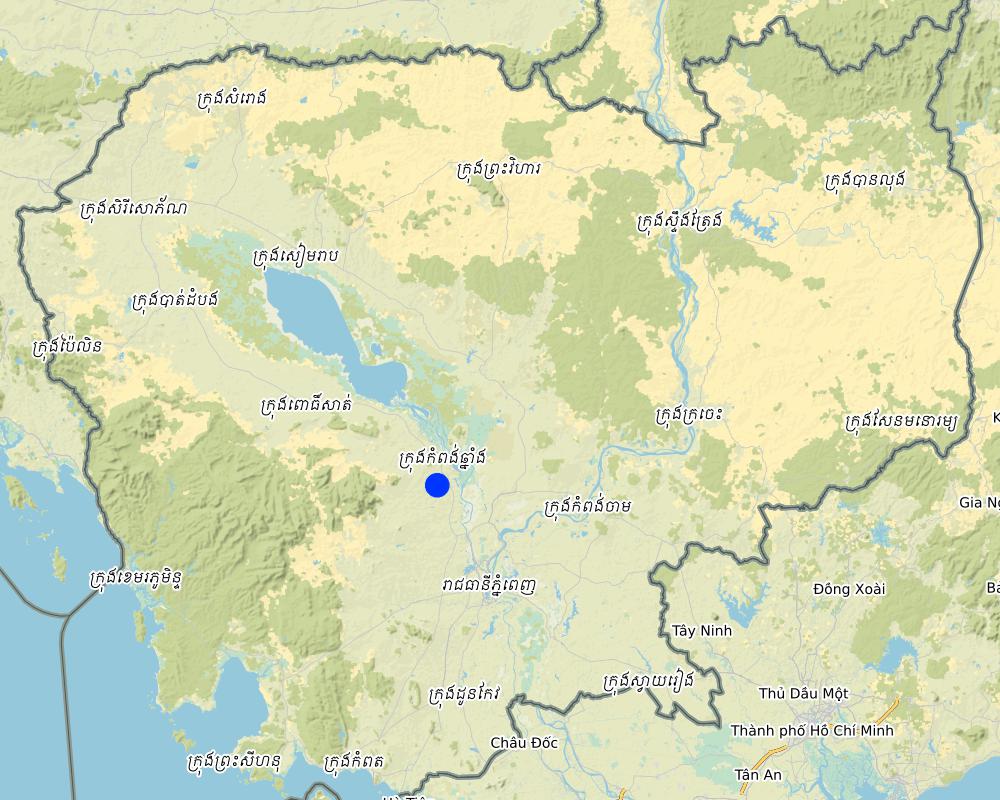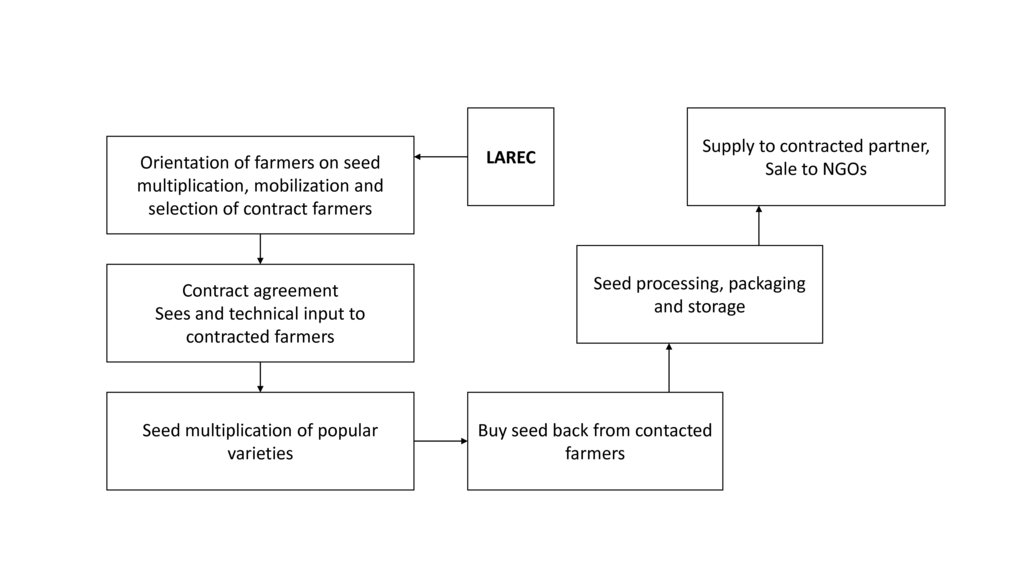Collection, selection, breeding and dissemination of locally adapted rice varieties at the Local Agricultural Research and Extension Centre LAREC. [กัมพูชา]
- ผู้สร้างสรรค์:
- การอัพเดท:
- ผู้รวบรวม: Stefan Graf
- ผู้เรียบเรียง: Judith Macchi, Stefan Graf, Christoph Kaufmann, Christine Lottje
- ผู้ตรวจสอบ: Boris Orlowsky, Alexandra Gavilano, Judith Macchi, Rima Mekdaschi Studer
approaches_1880 - กัมพูชา
- บทสรุปทั้งหมดในรูปแบบของ PDF
- บทสรุปทั้งหมดในรูปแบบของ PDF เพื่อพิมพ์
- บทสรุปทั้งหมดในรูปหน้าเว็บ
- บทสรุปทั้งหมด (ไม่มีการจัดเรียง)
- Collection, selection, breeding and dissemination of locally adapted rice varieties at the Local Agricultural Research and Extension Centre LAREC.: 29 สิงหาคม 2017 (inactive)
- Collection, selection, breeding and dissemination of locally adapted rice varieties at the Local Agricultural Research and Extension Centre LAREC.: 12 มีนาคม 2021 (inactive)
- Collection, selection, breeding and dissemination of locally adapted rice varieties at the Local Agricultural Research and Extension Centre LAREC.: 12 มีนาคม 2021 (public)
ดูส่วนย่อย
ขยายทั้งหมด ย่อทั้งหมด1. ข้อมูลทั่วไป
1.2 รายละเอียดที่ติดต่อได้ของผู้รวบรวมและองค์กรที่เกี่ยวข้องในการประเมินและการจัดเตรียมทำเอกสารของแนวทาง
วิทยากรหลัก
ผู้เชี่ยวชาญ SLM:
Khun Lean Hak
kleanghak@yahoo.com / sofdec@camintel.com
SOFDEC/LAREC
www.sofdec.com
กัมพูชา
ผู้เชี่ยวชาญ SLM:
Pith Khonhel
012 585892
khonhel@gmail.com
LAREC Local Agricultural Research and Extension Centre
www.sofdec.org
กัมพูชา
1.3 เงื่อนไขที่เกี่ยวข้องกับการใช้ข้อมูลที่ได้บันทึกไว้ผ่านทาง WOCAT
วันที่เก็บรวบรวมข้อมูล (ภาคสนาม):
01/08/2014
ผู้รวบรวมและวิทยากรหลักยอมรับเงื่อนไขเกี่ยวกับการใช้ข้อมูลที่ถูกบันทึกผ่านทาง WOCAT:
ใช่
2. คำอธิบายของแนวทาง SLM
2.1 การอธิบายแบบสั้น ๆ ของแนวทาง
Local genetic rice varieties which are better adapted to changing climatic conditions are collected on farms, tested, described, selected or bred into new varieties and again distributed to farmers with the goal to increase their food security
2.2 การอธิบายอย่างละเอียดของแนวทาง
การอธิบายอย่างละเอียดของแนวทาง:
Farmers in the central Cambodian province of Kampong Chhnang increasingly struggle with changing and unpredictable weather patterns and regular weather extremes. Lately, water supply has fluctuated annually due to alternating drought and flood extremes. Harvest yields from farmers in the region are low, amongst others, due to the use of low-quality seed, which is not adapted to local conditions, and which demands for an increase in the use of chemical fertilizers and pesticides.
Acknowledging the fact that with changing climatic conditions, local genetic resources and genetic diversity play a vital role to guarantee food security of smallholder farmers, the Local Agricultural Research and Extension Center – LAREC collects, selects, tests, breeds and disseminates rice varieties, which are better adapted to local conditions. To answer to the climate extremes of drought and flood, LAREC focusses its research on flood tolerant and drought resistant rice varieties.
Over the past years 36 flood tolerant rice varieties have been investigated by LAREC research staff for their floating ability and submergence tolerance. 6 varieties among these are: Pork Kraham, Chung Banla-6, STR010, STR10, STR 011 and Chung Banla-2, have been defined as the most appropriated varieties in term of stem elongation, submergence tolerance and yield. These are multiplied and recommended for farmers in flood prone areas.
Regarding drought tolerance LAREC bred a new variety derived from a cross between Phka Rumduol and IRRI breeding line. This variety is tested in an on farm adaptive trial to see crop performance under farmer practice. The two lines have a short growth duration range from 75 days to 90 days and are non-photo period sensitive. Besides the short growth duration, which makes them appropriate for drought prone areas, the new variety also has a desirable aroma which is important for acceptance and marketing purposes. However, to provide scientific evidence, thorough testing in on-farm trials is needed to see yield performance under farmers’ condition, seed rate application based on cultivation method and fertilizer application.
After the production of basic seed for rice LAREC distributes the seed to contract farmers for multiplication under the supervision of LAREC staff. The multiplied seed is distributed to interested buyers through LAREC and the local farmers' associations.
2.3 รูปภาพของแนวทาง
2.5 ประเทศ ภูมิภาค หรือสถานที่ตั้งที่ได้นำแนวทางไปใช้
ประเทศ:
กัมพูชา
ภูมิภาค/รัฐ/จังหวัด: :
Kampong Chhnang
ข้อมูลเฉพาะเพิ่มเติมของสถานที่ตั้ง:
Rolea Pha-ear
ความคิดเห็น:
Area where the seeds are used is 10-100 km2
Map
×2.6 วันที่เริ่มต้นและสิ้นสุดของแนวทาง
ระบุปีที่เริ่ม:
2010
2.7 ประเภทของแนวทาง
- ใช้โครงงานหรือแผนงานเป็นฐาน
2.8 เป้าหมายหรือวัตถุประสงค์หลักของแนวทาง
Provide high quality seeds of local varieties which are better adapted to changing climatic conditions to the farmers in the area.
2.9 เงื่อนไขที่เอื้ออำนวยหรือเป็นอุปสรรคต่อการนำเทคโนโลยีภายใต้แนวทางนี้ไปปฏิบัติใช้
บรรทัดฐานและค่านิยมทางสังคม วัฒนธรรม ศาสนา
- เอื้ออำนวย
The founding of LAREC as a local research station was needs-based, as a consequence of increasing exposure of farmer's rice yields to extreme weather events (drought and flood)
- เป็นอุปสรรค
Farmers are consulted in the selection of seed varieties, but not engaged in the research process.
There is a certain degree of aversion towards local varieties by the farmers, due to lower yields.
การมีไว้ให้หรือการเข้าถึงแหล่งการเงินและบริการ
- เอื้ออำนวย
The building up of LAREC (warehouse, office building, greenhouse, drying site, trial field) was rendered possible due to funding by SOFDEC/HEKS
ความรู้เกี่ยวกับ SLM การเข้าถึงการสนับสนุนด้านเทคนิค
- เอื้ออำนวย
Highly specialized research personnel working with local varieties adapted to local conditions
- เป็นอุปสรรค
Only limited knowledge transfer to farmers, as research is conducted in the center, not through a participatory breeding approach
ตลาด (จัดซื้อปัจจัยนำเข้า ขายผลิตภัณฑ์) และราคา
- เป็นอุปสรรค
LAREC struggels to become self-sustained by selling the seeds on the local market.
3. การมีส่วนร่วมและบทบาทของผู้มีส่วนได้ส่วนเสียที่เกี่ยวข้อง
3.1 ผู้มีส่วนได้ส่วนเสียที่เกี่ยวข้องในแนวทางนี้และบทบาท
- ผู้ใช้ที่ดินระดับท้องถิ่นหรือชุมชนระดับท้องถิ่น
Farmers
Farmers are involved in the selection of seeds and some contracted farmers act as seed multipliers for LAREC
- องค์กรที่ขึ้นอยู่กับชุมชน
Community committees
They play a role to facilitate and promote the seed produced by LAREC. They also support the selection of seeds and follow up on the contracting farmers
- นักวิจัย
LAREC reserach personnel
Selection, testing, breeding of adapted varieties
- องค์กรพัฒนาเอกชน
SOFDEC
HEKS (Swiss Church Aid)
SOFDEC provided 100% of the funding. SOFDEC staff links LAREC to the farmers and support the collection, dissemination promotion of the seeds and are also collecting feedback from farmers for discussion with LAREC team to find the solution.
HEKS (Swiss Church Aid) is the main backdonor of SOFDEC and hence of LAREC.
- รัฐบาลแห่งชาติ (ผู้วางแผน ผู้ทำการตัดสินใจ)
Cambodian Agricultural Research and Development Institute (CARDI)
CARDI plays an advisory role and also supports the promotion of LAREC.
LAREC is linked to CARDI to exchange on seed multiplication
3.2 การเกี่ยวข้องของผู้ใช้ที่ดินระดับท้องถิ่นหรือชุมชนระดับท้องถิ่นในช่วงต่างๆของแนวทาง
| ความเกี่ยวข้องของผู้ใช้ที่ดินระดับท้องถิ่นหรือชุมชนระดับท้องถิ่น | ระบุผู้ที่มีส่วนเกี่ยวข้องและอธิบายกิจกรรม | |
|---|---|---|
| การริเริ่มหรือการจูงใจ | ไม่ลงมือ | LAREC was initiated by SOFDEC, as a consequence of an increasing exposure of farmer's rice yields to weather extremes (drought/flood) |
| การวางแผน | ไม่มี | Planning of the center by SOFDEC |
| การดำเนินการ | ไม่ลงมือ | LAREC collects seed varieties on farms, tests, selects, breeds and disseminates seed again to farmers. Farmers do the multiplication of seeds and use the adapted varieties for their rice production (own consumption and for the market) |
| การติดตามตรวจสอบหรือการประเมินผล | ไม่มี | M+E is conducted by LAREC, SOFDEC and HEKS ((internally) as well as by external evaluators (at the end of each project phase) |
| Research | ไม่ลงมือ | Selection of promising varieties is done in consultation with the farmers. Research with the selected crops is done entirely on the LAREC site. |
3.3 แผนผังแสดงขั้นตอนการทำงาน (ถ้ามี)
3.4 การตัดสินใจเลือกใช้เทคโนโลยี SLM
ระบุผู้ที่ทำการตัดสินใจเลือกเทคโนโลยีมากกว่าหนึ่งวิธีไปปฏิบัติใช้:
- ผู้เชี่ยวชาญ SLM เป็นผู้ตัดสินใจหลัก ที่ติดตามให้คำปรึกษากับผู้ใช้ที่ดิน
การอธิบาย:
The selection of the breeding lines is conducted with farmers. Research and testing of the selected varieties is done entirely on the LAREC site, without farmers involvement.
LAREC decides on how and where the adapted varieties were distributed.
ระบุว่าการตัดสินใจตั้งอยู่บนพื้นฐานของ:
- สิ่งที่ค้นพบจากงานวิจัย
- ประสบการณ์และความคิดเห็นส่วนตัว (ไม่ได้ลงบันทึกไว้)
4. การสนับสนุนด้านเทคนิค การสร้างขีดความสามารถ และการจัดการด้านความรู้
4.1 การสร้างขีดความสามารถ / การอบรม
ได้มีการจัดอบรมให้แก่ผู้ใช้ที่ดินหรือผู้มีส่วนได้ส่วนเสียคนอื่น ๆ หรือไม่:
ใช่
ให้ระบุว่าใครเป็นผู้ได้รับการอบรม:
- ผู้ใช้ที่ดิน
รูปแบบการอบรม:
- จัดคอร์ส
หัวข้อที่พูด:
Contract farmers are trained on seed production and seed storage.
4.2 การบริการให้คำแนะนำ
ผู้ใช้ที่ดินมีการเข้าถึงการรับบริการให้คำปรึกษาหรือไม่:
ไม่ใช่
4.3 การเสริมความแข็งแกร่งให้กับสถาบัน (การพัฒนาองค์กร)
สถาบันได้รับการจัดตั้งขึ้นมาหรือเสริมความแข็งแกร่งโดยแนวทางนี้หรือไม่:
- ใช่ อย่างมาก
ระบุระดับของสถาบันที่ได้รับการเสริมความแข็งแกร่งหรือจัดตั้งขึ้นมา:
- ท้องถิ่น
อธิบายถึงสถาบัน บทบาทและความรับผิดชอบ สมาชิก เป็นต้น:
Establishment of a local agricultural research center
ระบุประเภทของการให้ความช่วยเหลือสนับสนุน:
- ด้านการเงิน
- การสร้างขีดความสามารถ / การอบรม
- อุปกรณ์
4.4 การติดตามตรวจสอบและประเมินผล
การติดตามตรวจสอบและประเมินผลเป็นส่วนหนึ่งของแนวทางหรือไม่:
ใช่
ความคิดเห็น:
Yearly monitoring of number of land users using selected of new varieties. Ad-hoc measurements of yield (carried out by project staff)
ถ้าตอบว่าใช่ แสดงว่าการจัดเตรียมเอกสารนี้มุ่งหวังที่จะเอาไปใช้สำหรับการติดตามตรวจสอบและประเมินผลใช่หรือไม่:
ใช่
ความคิดเห็น:
The documentation of yield and land users involved is used for measuring outputs and outcomes of the project based on the indicators set in proposal. This is also used for routine monitoring by project staff as well as for mid-term and end project-phase evaluations.
4.5 การวิจัย
การวิจัยเป็นส่วนหนึ่งของแนวทางหรือไม่:
ใช่
ระบุหัวข้อเรื่อง:
- เทคโนโลยี
ให้ข้อมูลเพิ่มเติมและให้ระบุผู้ทำการวิจัย:
Research to select and improve local rice varieties to be better adapted to changing climatic conditions is the main activity of the approach.
5. การสนับสนุนด้านการเงินและวัสดุอุปกรณ์
5.1 ระบุงบประมาณประจำปีสำหรับแนวทาง SLM นี้
ถ้าหากว่างบประมาณประจำปีไม่เป็นที่ทราบแน่นอน ให้ระบุช่วงลงไป:
- 10,000-100,000
5.2 การสนับสนุนด้านการเงิน / วัสดุอุปกรณ์ให้แก่ผู้ใช้ที่ดิน
ผู้ใช้ที่ดินได้รับการสนับสนุนด้านการเงิน / วัสดุอุปกรณ์ไปปฏิบัติใช้เทคโนโลยีหรือไม่:
ไม่ใช่
5.3 เงินสนับสนุนสำหรับปัจจัยนำเข้า (รวมถึงแรงงาน)
- อุปกรณ์
| ระบุปัจจัยนำเข้าที่ได้รับการสนับสนุน | เห็นด้วยระดับไหน | ระบุเงินสนับสนุน |
|---|---|---|
| เครื่องจักร | ได้รับการช่วยเหลือทางการเงินแบบเต็ม | |
| เครื่องมือ | ได้รับการช่วยเหลือทางการเงินแบบเต็ม | |
- วัสดุสำหรับการก่อสร้าง
| ระบุปัจจัยนำเข้าที่ได้รับการสนับสนุน | เห็นด้วยระดับไหน | ระบุเงินสนับสนุน |
|---|---|---|
| หิน | ได้รับการช่วยเหลือทางการเงินแบบเต็ม | |
ถ้าแรงงานโดยผู้ใช้ที่ดินเป็นปัจจัยนำเข้าที่มีอยู่มากมาย ระบุด้วยว่าเนื่องจาก:
- สมัครใจ
5.4 เครดิต
มีการจัดหาเครดิตมาให้ภายใต้แนวทาง SLM หรือไม่:
ไม่ใช่
5.5 แรงจูงใจหรือเครื่องมืออื่น ๆ
แรงจูงใจหรือเครื่องมืออื่น ๆ ได้ถูกนำไปใช้ส่งเสริมการใช้เทคโนโลยี SLM หรือไม่:
ไม่ใช่
6. การวิเคราะห์ผลกระทบและการสรุป
6.1 ผลกระทบของแนวทาง
ช่วยให้ผู้ใช้ที่ดินนำเอาเทคโนโลยี SLMไปใช้และบำรุงรักษาสภาพไว้ได้หรือไม่:
- ไม่ใช่
- ใช่ เล็กน้อย
- ใช่ ปานกลาง
- ใช่ อย่างมาก
Farmers have access to seed varieties which are adapted to local conditions (e.g. drought and flood resistance), ensuring that yields are also generated in case of an extreme weather event.
นำไปสู่ความมั่นคงด้านอาหารหรือปรับปรุงโภชนาการให้ดีขึ้น:
- ไม่ใช่
- ใช่ เล็กน้อย
- ใช่ ปานกลาง
- ใช่ อย่างมาก
Through the use of seed varieties which are adapted to local conditions, (e.g. drought and flood resistance) farmers increase their food security by ensuring that yields are also generated in case of an extreme weather event. Farmers are more resilient against extreme weather events.
ปรับปรุงความสามารถของผู้ใช้ที่ดินในการปรับตัวให้เข้ากับการเปลี่ยนแปลงของสภาพภูมิอากาศหรือสภาพที่รุนแรงและภัยพิบัติหรือไม่:
- ไม่ใช่
- ใช่ เล็กน้อย
- ใช่ ปานกลาง
- ใช่ อย่างมาก
Through the use of seed varieties which are adapted to local conditions, (e.g. drought and flood resistance) farmers increase their food security by ensuring that yields are also generated in case of an extreme weather event. Farmers are more resilient against extreme weather events.
นำไปสู่โอกาสในการจ้างงาน รายได้หรือไม่:
- ไม่ใช่
- ใช่ เล็กน้อย
- ใช่ ปานกลาง
- ใช่ อย่างมาก
Additional income for contract farmers through seed multiplication
6.2 แรงจูงใจหลักของผู้ใช้ที่ดินเพื่อที่จะนำ SLM ไปปฏิบัติใช้
- ความเสี่ยงของภัยพิบัติลดลง
Adapted varieties also perform in the case of an extreme weather event (drought/flood)
6.3 ความยั่งยืนของกิจกรรมของแนวทาง
ผู้ใช้ที่ดินสามารถทำให้สิ่งต่างๆ ที่ได้ปฏิบัติใช้โดยแนวทางนี้ยั่งยืนได้หรือไม่ (โดยไม่มีการสนับสนุนจากภายนอก):
- ไม่แน่ใจ
ถ้าตอบว่าไม่หรือไม่แน่ใจ ให้ระบุและแสดงความคิดเห็น :
If the seeds are not promoted through a project (e.g. by SOFDEC), it is up to the farmers to buy the adapted varieties.
6.4 จุดแข็งและข้อได้เปรียบของแนวทาง
| จุดแข็ง / ข้อได้เปรียบของแนวทางในทัศนคติของผู้ใช้ที่ดิน |
|---|
| Seeds of high quality are provided by LAREC. |
| Quality of crops from LAREC-seed is uniform and varieties are demanded on the market, thus contributing to an increasing farmer income. |
| Increased food-security as adapted seeds also perform in the likelihood of an extreme weather event. |
| จุดแข็ง / ข้อได้เปรียบของแนวทางในทัศนคติของผู้รวบรวมหรือวิทยากรหลัก |
|---|
| Seeds are collected in the region from the farmers, thus adapted to the local conditions. (They are collected in the research center and in addition the center buys foundation seeds from the Cambodian Agricultural Research and Development Institute (CARDI) in order to scale up). |
6.5 จุดอ่อน / ข้อเสียเปรียบของแนวทางและวิธีในการแก้ไข
| จุดอ่อน / ข้อเสียเปรียบในทัศนคติของผู้รวบรวมหรือวิทยากรหลัก | สามารถแก้ไขปัญหาได้อย่างไร |
|---|---|
| Farmers are still dependent on getting new seeds of the selected varieties (every 3 years for rice) as seeds get mixed and cross pollination occurs. | |
| Lack of money to store the seeds in a proper way. Lack of material (silica gel, oven). | Find external financing sources. Connect with international seed saving organisations if collection and distribution of local ecotypes gets a higher priority. |
| Breeding and selection is not happening on-farm, only at the LAREC centre. Land users remain highly dependent on LAREC to provide new seeds every few years. | Implement participatory plant breeding. Train farmers in selection (already happening with mung bean and rice) and breeding. |
7. การอ้างอิงและการเชื่อมต่อ
7.1 วิธีการหรือแหล่งข้อมูล
- ไปเยี่ยมชมภาคสนาม การสำรวจพื้นที่ภาคสนาม
- การสัมภาษณ์กับผู้ใช้ที่ดิน
- การเก็บรวบรวมมาจากรายงานและเอกสารที่มีอยู่
7.2 การอ้างอิงถึงสิ่งตีพิมพ์
ชื่อเรื่อง ผู้เขียน ปี ISBN:
Paris, T., et al. 2011. Guide to participatory varietal selection for submergence-tolerant rice. IRRI
ช่องทางในการสืบค้น และราคา:
www.irri.org
7.3 เชื่อมโยงกับข้อมูลที่มีอยู่บนออนไลน์
ชื่อเรื่องหรือคำอธิบาย:
The Society for Community Development in Cambodia (SOFDEC) is a Cambodian Non-Governmental Organization, established in 2006 through the localization of HEKS (the Swiss Church Aid) project in Kampong Chhnang province, Cambodia. The vision of SOFDEC is that Cambodian people living in Cambodia live a state of comfort, equality, equity, and have ownership over the sustainable development of their community. The mission of SOFDEC works in partnership with community based organizations and relevant institutions through integrated community development, research, human resource development, enhancement of family economies, in the hopes to uplift the living standards of the people in the target areas. Our goal aims to uplift the living standards of the rural people of Cambodia through the improvement in income generation, sustainable agricultural practices, microfinance, health, human resource development, and sustainable natural resource management.
URL:
www.sofdec.com
ลิงก์และโมดูล
ขยายทั้งหมด ย่อทั้งหมดลิงก์
ไม่มีลิงก์
โมดูล
ไม่มีโมดูล


